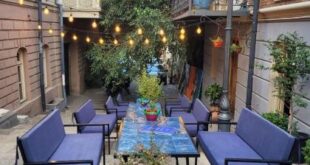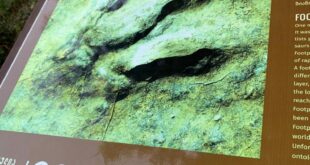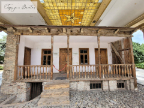Mtskheta, Georgia: The Sacred Side of Georgia
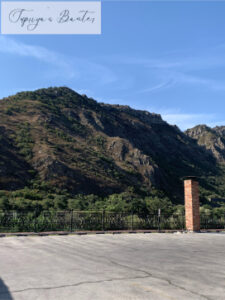
Mtskheta, Georgia’s original capital, is one of the oldest continuously inhabited cities in the world. It was where the country first adopted Christianity in 334.
Today, it is the headquarters of the Georgian Orthodox and Apostolic Church and home to Jvari Monastery and Svetitskhoveli Cathedral, both UNESCO-listed Historical Monuments.
Visiting Mtskheta provides insight into the religious and historical side of Georgia.
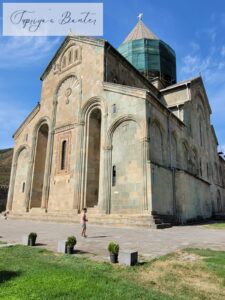
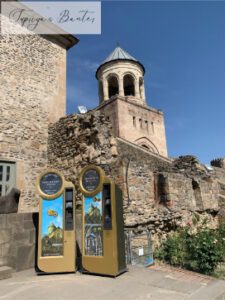
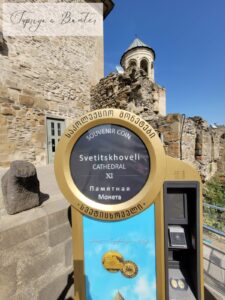
Soaking into the sacred spirit
Our tour started at the Jvari Monastery (Monastery of the Holy Cross), located on a rocky hill overlooking the Mtkvari and Aragvi rivers and the town of Mtskheta. Read more about Jvari Monastery here.
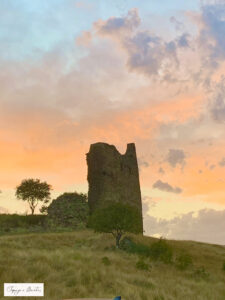
Svetitskhoveli Cathedral: Primary Orthodox Georgian Church
Then, we descended from the hilltop to Svetitskhoveli Cathedral, located in the centre of the charming town of Mtskheta. Svetitskhoveli is an excellent example of medieval Georgian architecture and serves as the main Orthodox Christian Cathedral in Georgia.
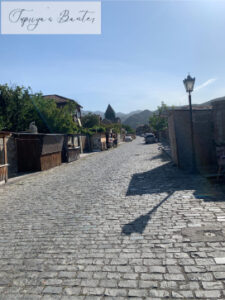
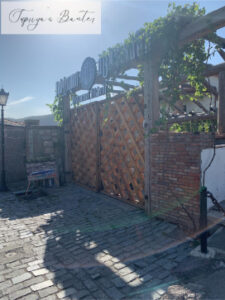
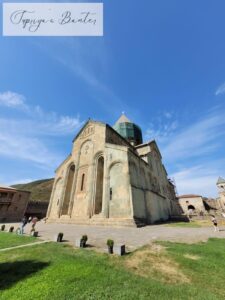
It is a significant pilgrimage site along the Silk Road, housing the resting place of Christ’s Robe and the burial site of Georgian monarchs. Constructed between 1010 and 1029, it is listed as a UNESCO World Heritage Site. Its name meaning “live-giving pillar,” has an interesting legend attached.
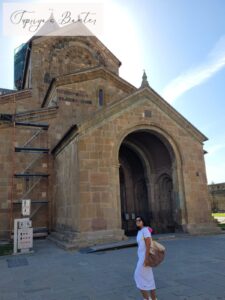
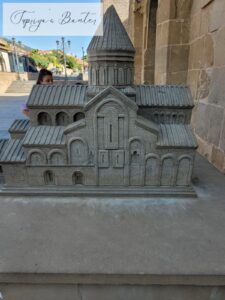
Legends and Lore
The stories associated with this church are quite impressive.
In the first century, a Georgian Jew named Elias from Mtskheta claimed to have purchased the Robe of Jesus after witnessing Christ’s crucifixion. Elias then brought the robe to Georgia and gave it to his sister, Sidonia. Overwhelmed with emotion, she collapsed and died. When the robe couldn’t be removed from her grasp, she was buried with it in the place. A cypress tree grew on her grave, and standing beneath its branches cured people of their diseases.
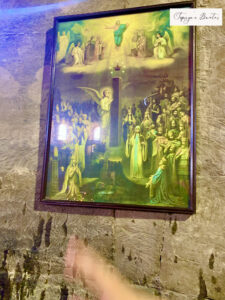
One of the paintings at Jvari Monastery shows the floating pillar from a Cypress tree that stood at the Svetitskhoveli Cathedral.
King Mirian built a church on the site. He cut down the cypress and shaped it into seven pillars, which were to be used as foundation pillars for the church. One of the seven columns is said to have magically floated up in the air. The column apparently returned to earth only after St. Nino prayed through the night. A sacred liquid, which cured people of all diseases, flowed from this column.
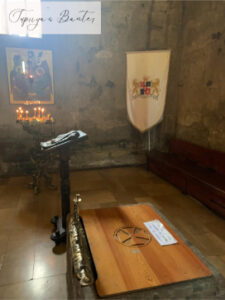
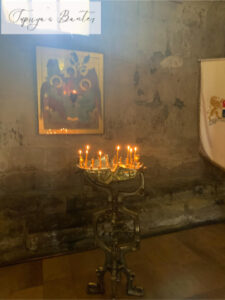
The cathedral was named after this legend. “Sveti” apparently means “pillar” and “tskhoveli” or “life-giving” or “living,” and that’s why the name Svetitskhoveli Cathedral.
A peek into the history
The original Svetitskhoveli Cathedral was built in the 4th century. Although that first church was destroyed, the grave containing the Robe of Jesus was left intact. The current cathedral dates to the 11th century. It is said to have been built by the Catholicos-Patriarch Melchizedek, the leader of the Orthodox religion, along with King George I.
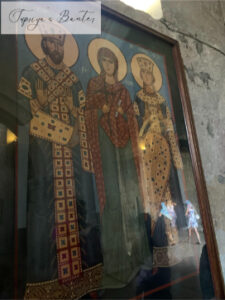
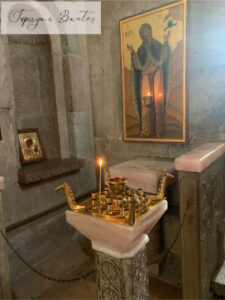
After the completion, it is said that the king cut off the right hand of the architect, Arsukidze. Officially, it was to ensure that the architect could never make something as beautiful as Svetitskhoveli again. However, there were claims that the architect’s hand had been cut off as a punishment because he loved the same woman as the king. The cathedral roof features a carving of the architect’s hand and forearm holding a chisel.
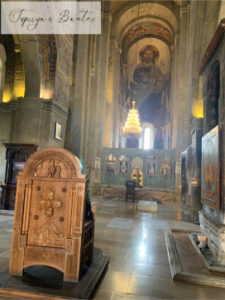
Architectural Wonder
After passing through a long cobblestone street, we reached one of the two large stone archways leading to Svetitskhoveli Cathedral.
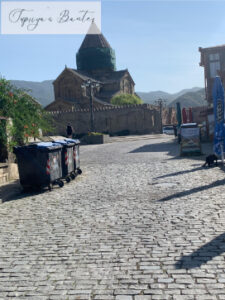
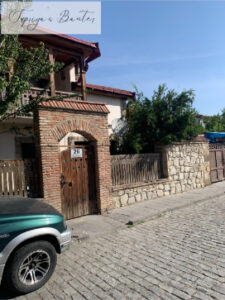

The temple’s facades are enriched with characteristic Georgian architectural stone carvings, including arched window frames, carved reliefs, niches, and the figures of flying angels, remnants of the previous 4th-century temple. Most original frescoes were destroyed in the 19th century.
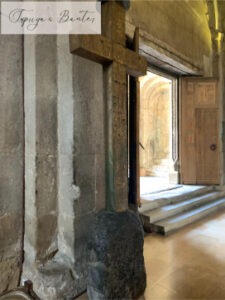
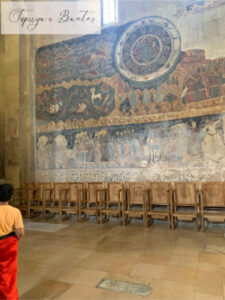
The play of light through the stained-glass windows created an ethereal glow, enhancing the cathedral’s mystical ambience. The cathedral’s cross-shaped floor plan and towering central dome created a sense of celestial grandeur.
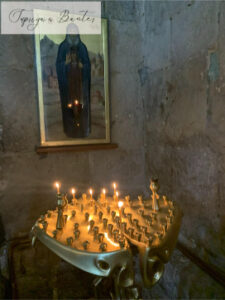
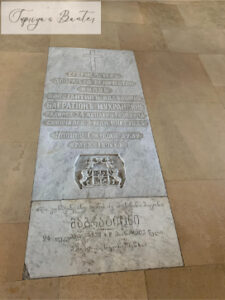
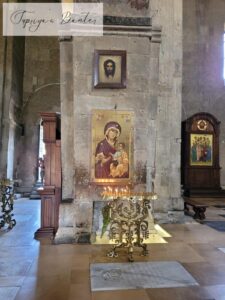
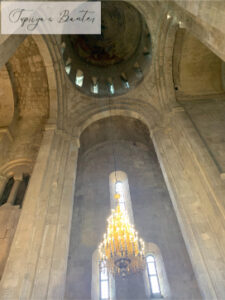
The cathedral contains graves of Georgian kings, remnants of the life-giving column, Sidonia’s grave, and Jesus’ robe. Standing there, one feels a profound connection to the past, as if the echoes of ancient prayers and chants were woven into the very fabric of the stone.
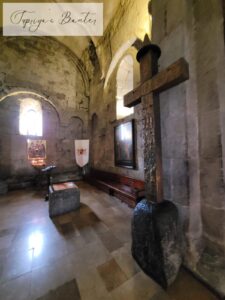
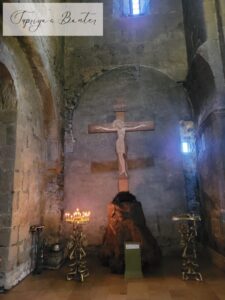
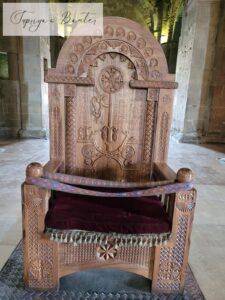
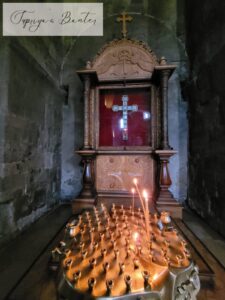
Svetitskhoveli isn’t just a historical site; it’s a living symbol of faith. The cathedral is said to house the vestments of Christ, and it is a significant pilgrimage site.
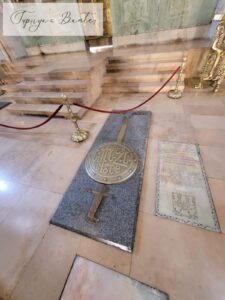
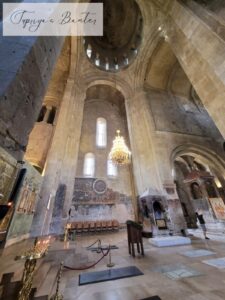
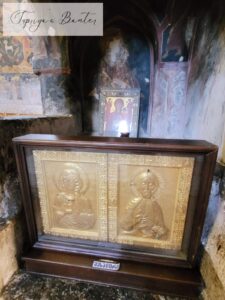
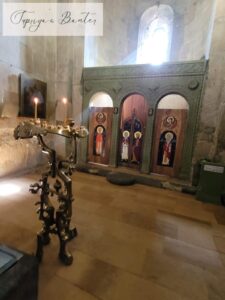
The current cross-in-square structure was completed in 1010-1029 on the site, dating back to the 4th century. Defensive walls were added in 1787. This historic cathedral is a masterpiece of the Early and High Middle Ages. This historic cathedral is a masterpiece of the Early and High Middle Ages.
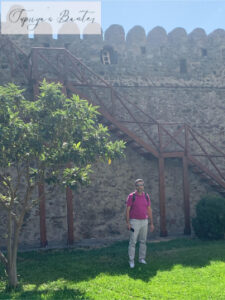
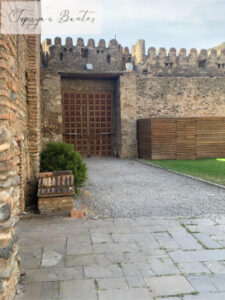
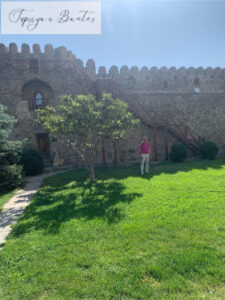
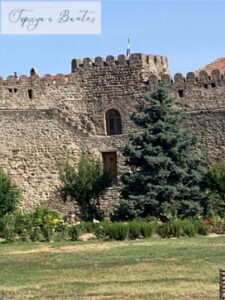
The grapevine cross
There is a sculpture at Svetitskhoveli Cathedral in Mtskheta, Georgia, which depicts the holy cross brought to Georgia by Saint Nino.
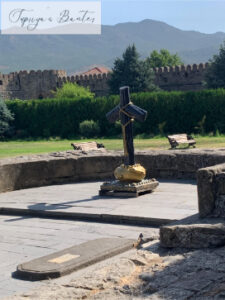
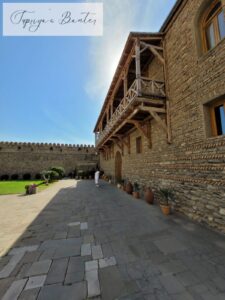
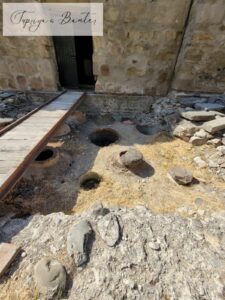
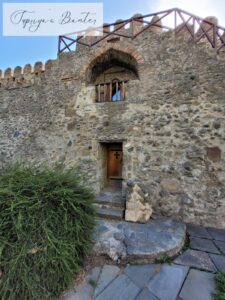
The grapevine cross is distinguished by the slight drooping of its horizontal arms. According to traditional accounts, Saint Nino is credited with this unusual shape of the cross. According to the legend, Saint Nino received it from the Virgin Mary. Some say she created it herself on the way to Mtskheta, securing it by entwining it with her own hair. Nino brought this cross on her mission to Georgia.
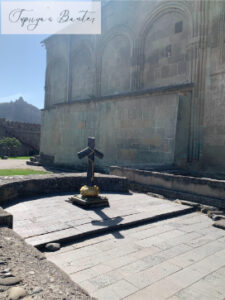
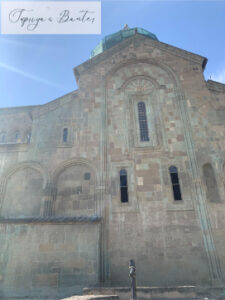


Other Nearby Churches/Monasteries
This wasn’t the only church in the vicinity. Several more are listed with UNESCO, and one is just a two-minute drive away. The small domed church on the grounds of Samtavro Monastery was supposedly built by St. Nino of Cappadocia, who came here in the 4th century to convert Georgia to Christianity. St. Nino’s Church, located on the grounds of Samtavro Monastery, is accompanied by a large church built by King Marian III in the 4th century and later reconstructed in the 11th century. This larger church still holds the tombs of King Marian III and his wife, Queen Nana.
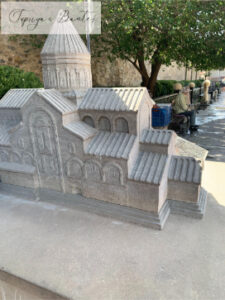

What Makes Svetitskhoveli Special?
Mtskheta’s commercial significance waned when the capital moved to Tbilisi in the 6th century. However, the Svetitskhoveli Cathedral remains spiritually significant. Despite facing invasions and changes of rule, it grew into the largest cathedral in Georgia. Despite these alterations, Svetitskhoveli has retained the majestic form given to it by Arsukidze in 1029.
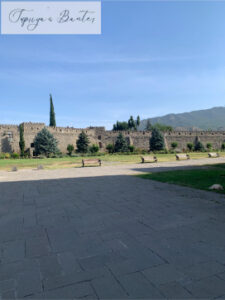
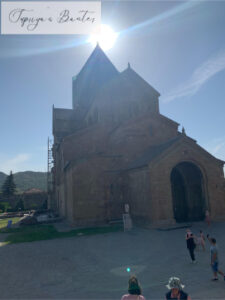
Today, it remains the symbolic heart of the Georgian Orthodox faith and a UNESCO World Heritage Site, attracting visitors seeking its serene and spiritual atmosphere.
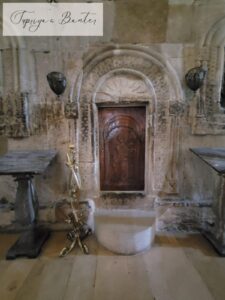
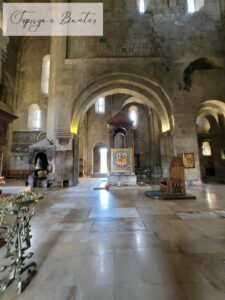
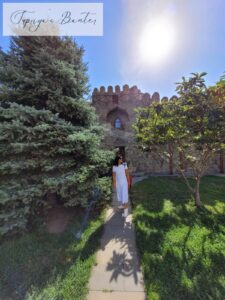
Since its construction, it has been the main place of worship for the Georgian Orthodox community.
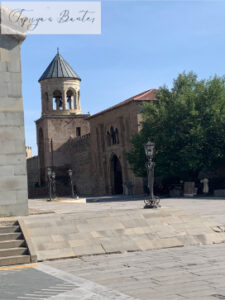
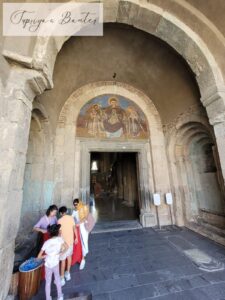

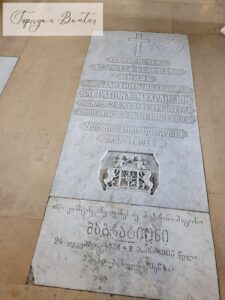
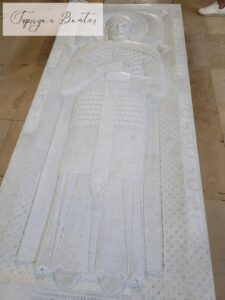
Street Sweets: A Sweet Adventure
Stepping outside the cathedral, one is greeted by the lively buzz of the local bazaars. The markets around Svetitskhoveli are a sensory overload in the best possible way. The vibrant stalls overflow with handmade souvenirs, from street snacks to unique Georgian jewellery.
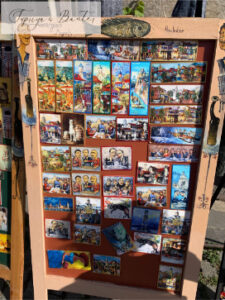
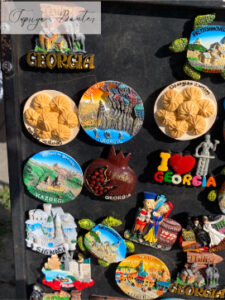
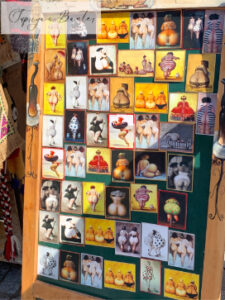

Georgian Snickers
But let’s talk about the real treat here—the street sweets! The bazaars and local shops are a haven for anyone with a sweet tooth. As I meandered through the bustling market, the air was filled with the irresistible aromas of street food delights.
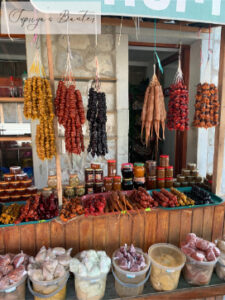
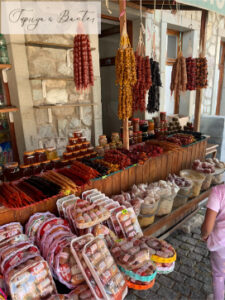
One of the most enchanting experiences was sampling the local sweets. At one kiosk, Anna, our guide, introduced us to “Georgian Snickers,” known locally as Churchkhela. These delightful Georgian candies are long strands of nuts and dried fruits dipped in a thick, sweet grape juice mixture and dried to chewy perfection.
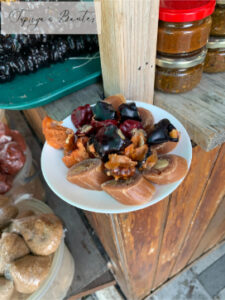
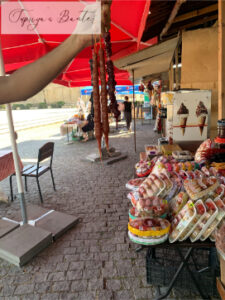
Each bite was a taste of tradition, rich with the flavour of sweetened grapes and crunchy nuts.
Kvass, a less-known cousin to kombucha
And then there’s the scent of freshly baked puri, Georgian bread, still warm from the oven. It’s golden and crusty on the outside, with a soft, pillowy centre that pairs perfectly with a sprinkle of cheese or a dab of honey. It’s comfort food in its purest form.


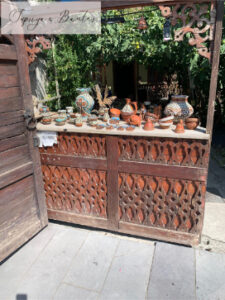
For a refreshing twist, try the local kvass—a fermented rye bread drink that’s tangy and slightly sour. It’s a unique beverage that provides a delicious contrast to the sweet treats and is perfect for quenching your thirst as you explore the vibrant market scene.
Tips
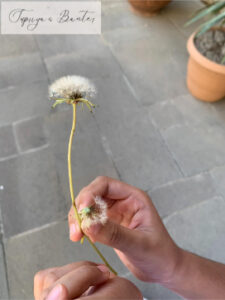
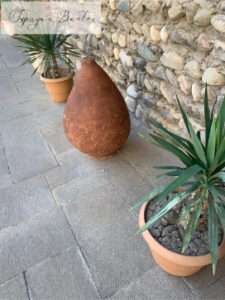
Modest dressing is preferable as a mark of respect for this sacred space. Make sure to leave plenty of time to explore Mtskheta’s lively streets and savour its local flavours.
The Jvari Monastery of the Holy Cross, Svetitskhoveli Cathedral, and Samtavro Monastery are important medieval landmarks in Georgia. The existing churches incorporate earlier structures and ancient wall paintings
The Svetitskhoveli Cathedral and Jvari Monastery are both UNESCO-listed historical monuments and popular tourist sites in Georgia.
Despite attracting many visitors, they did not feel overly touristy. In fact, the majority of the visitors were local people who came to pray or make devotions, as they have been doing for the past 1,400 years.
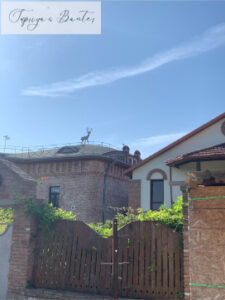
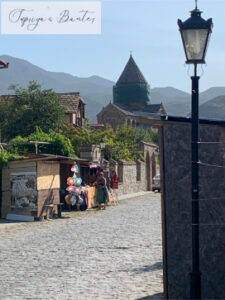
So, if you find yourself in Mtskheta, take the time to wander through these extraordinary pieces of history. I promise it will be worth it.
Continue Reading:
Georgia: A Wine Lover’s Dream Wrapped in Legends and History
Jvari Monastery: A Glimpse into Georgia’s Past
Uplistsikhe: The Enigmatic Cave City of Georgia
Stalin Museum: A Journey into Georgia’s Complex Past
The Majestic Okatse Canyon: Georgia’s Natural Marvel
Crossing the Crystal Chasm: Georgia’s Diamond Glass Bridge
 Supriya's Banter
Supriya's Banter
